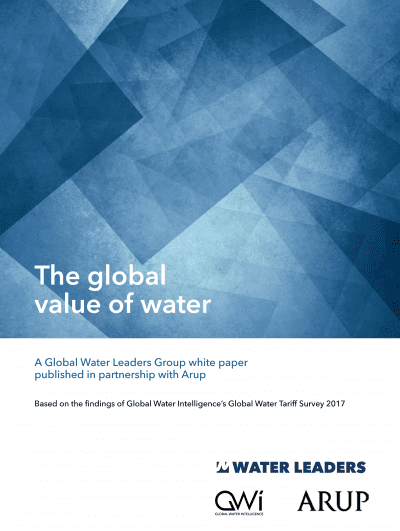Singapore Implements its First Tariff Increase in 17 Years to Secure its Future Water Needs

The Public Utilities Board of Singapore (PUB) implemented this year its first tariff hike in 17 years to secure Singapore’s future water needs, and to manage the risk of extreme weather and water scarcity driven by climate change, the results of the Global Water Tariff Survey 2017 have shown.
The 2017 results were released in a new White Paper entitled The Global Value of Water, published by GWI and the Global Water Leaders Group (GWLG) in partnership with Arup, and featuring commentaries from GWLG members and Alexander Danilenko, Senior Water and Sanitation Specialist at The World Bank.
The results show Singapore’s first tariff hike since 2000 as part of a longer-term strategy. Rates in the city-state will increase 30% phased over 2 years, with the next increase expected in 2018.
Singaporean water tariffs are set by parliament. However, despite decades of investment in desalination and wastewater reuse facilities, the government did not find the right time to increase the tariff until earlier this year – one year into the five-year election cycle.
The rate hike was carried out in order to fund new investments towards NEWater and desalination sources to secure Singapore’s future water needs, with PUB expecting these alternative sources to meet 85% of Singapore’s future water needs by 2060.
“To encourage prudent usage and ensure sustainability, PUB prices water to the cost of producing it from the next available source, which is likely to be from NEWater and desalination.” A spokesperson from PUB told the GWLG.
The increase in tariffs was also implemented to generate the revenue needed to manage the risk of extreme weather and water scarcity driven by climate change. PUB told the GWLG it expects wet seasons in the region to become wetter in the future, and for dry seasons to become drier.
The white paper revealed that over the next five years, PUB’s investment in water infrastructure will be about $4 billion to meet growing demand and to boost the resilience of the water system, especially to face the challenges posed by climate change.
The rising costs of producing water, as major investments are made in water infrastructure, along with more expensive methods of development due to greater urbanisation, have also furthered the need to adjust water prices accordingly.
Singapore’s tariffs remain low compared to European or American levels however, partly because the government subsidises all costs related to drainage, and the capital costs of sewerage activities.
According to the Global Water Tariff Survey’s Affordability Index, Singaporean residents spend just 0.29% of their household income on drinking water, but consume water at a rate above cities that are equally affordable, such as London or Ottawa. As consumption rates migrate down, there is scope for rising tariffs to recover more costs in the future.
The Global Value of Water and The Global Water Tariff Survey are available as part of a subscription to GWI Magazine, visit www.globalwaterintel.com/gwi/tariffsurvey


